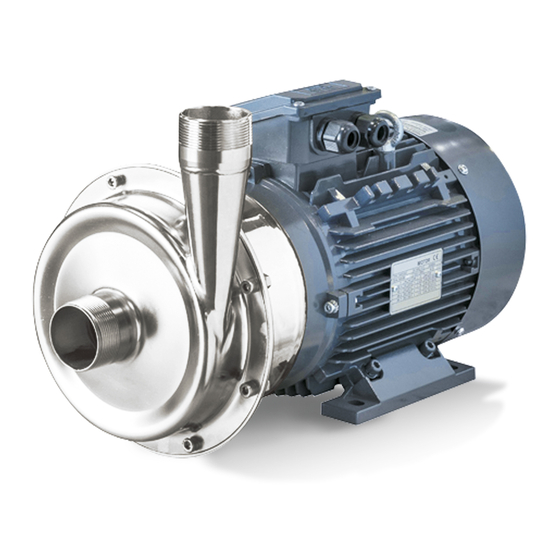
Table of Contents

Summarization of Contents
Introduction
Check the Shipment
Verify pump contents against shipping voucher upon receipt.
Instructions Manual
Details regarding manual updates, modifications, and usage rights.
Maintenance
Highlights the necessity of routine maintenance for the pump.
Operating Principles
Covers general operational guidelines and safety symbols.
Safety
Essential safety instructions and symbols for pump operation and handling.
Warranty
Conditions under which the product warranty becomes null and void.
INOXPA Service
Contact information for technical support and inquiries.
General Information
Description
Details about the ESTAMPINOX ES, ER, EFH, EFN centrifugal pump series.
Materials Used in Construction
Information on materials for pump parts in contact with the liquid.
Shaft Sealing
Options for mechanical seals, including materials for faces and elastomers.
Field of Application
Illustrates pump performance curves for different models and operating conditions.
Installation
General Considerations
Basic instructions for pump installation, emphasizing shop foreman's role.
Location and Accessibility
Guidelines for pump placement and accessibility for maintenance.
Excessive Temperatures
Operational considerations for pumps handling high-temperature fluids.
Stability and Foundation
Requirements for a level, rigid, and vibration-resistant foundation.
Handling
Instructions for safe handling of the pump, especially when supplied without a motor.
Electric Motors
Regulations and safety for connecting electric motors, including overload protection.
Direction of Rotation
Specifies clockwise rotation and its impact on performance.
Suction and Discharge Pipes
Guidance on pipe sizing, layout, and avoiding air pockets for optimal suction.
Start-up
General Considerations
Prerequisites for starting the pump, including informed personnel and pre-start checks.
Cleaning
Ensuring pipes and pump are clean before start-up, referencing cleaning procedures.
Start-up Procedure
Steps for safely starting the pump, checking suction pressure, and discharge control.
Maintenance
General Considerations
Importance of proper maintenance for pump longevity and safety.
Conservation
Procedure for preserving the pump during long periods of inactivity.
External Cleaning
Guidelines for keeping the pump exterior clean and avoiding damage from water.
Electrical Installation Maintenance
Safety precautions for electrical maintenance, requiring qualified personnel and power cutoff.
General Maintenance
Routine checks on pressures, motor inspection, and mechanical seal care.
Operating Problems
Overloading of Motor
Identifies probable causes for motor overloading.
Insufficient Flow Rate or Pressure
Lists probable causes for reduced pump performance.
No Discharge Pressure
Probable causes for lack of pressure on the discharge side.
Irregular Flow Rate or Pressure
Probable causes for inconsistent flow or pressure output.
Noise and Vibrations
Identifies probable causes for pump noise and vibration issues.
Pump Clogging
Probable causes when the pump becomes clogged.
Overheating of Pump
Identifies probable causes for pump overheating.
Abnormal Wear
Probable causes for abnormal wear on pump components.
Leak in Mechanical Seal
Probable causes for leaks in the mechanical seal.
Disassembly and Assembly
General Considerations
Emphasizes qualified personnel and adherence to manual for safe disassembly.
Safety Precautions
Key safety steps before starting disassembly, including motor prevention.
Disconnection Procedure
Steps to safely disconnect the pump and pumping unit before disassembly.
Electrical Safety
Critical electrical safety measures before working on pumps with motors.
Pump Housing Disassembly
Steps for removing the pump housing, noting potential liquid spills.
Impeller and Pump Cover Disassembly
Procedure for disassembling the impeller and pump cover, including seal parts.
Mechanical Seal Procedures
Detailed steps for disassembling and assembling the mechanical seal components.
Impeller Assembly
Instructions for correctly mounting the impeller onto the shaft.
Motor Replacement
Guidance on replacing the motor, referring to specific disassembly steps.
Technical Specifications
Technical Specifications Data
Detailed table of pump types, motor power, sealing shaft, impeller diameter, and weight.
Materials of Construction
Lists parts in contact with the liquid and their respective materials.
Parts List Estampinox ES
Detailed breakdown of parts for the Estampinox ES pump series.
Parts List Estampinox ER
Detailed breakdown of parts for the Estampinox ER pump series.
Parts List Estampinox EFH
Detailed breakdown of parts for the Estampinox EFH pump series.
Parts List Estampinox EFN
Detailed breakdown of parts for the Estampinox EFN pump series.
Cleaning and Disinfection
General Considerations
Importance of cleaning and disinfection in industrial processes, especially food industry.
Cleaning Methods
Describes methods for pump cleaning: CIP and disassembly.
Safety in Cleaning and Disinfection
Crucial safety measures for manual and CIP cleaning to prevent accidents.
Manual Cleaning Procedures
Steps for safe manual cleaning, including disconnecting power and using PPE.
CIP Procedure
Guidelines for safe CIP cleaning, ensuring connections are secure and avoiding automatic start-up.
















Need help?
Do you have a question about the ESTAMPINOX EFI-2355 and is the answer not in the manual?
Questions and answers